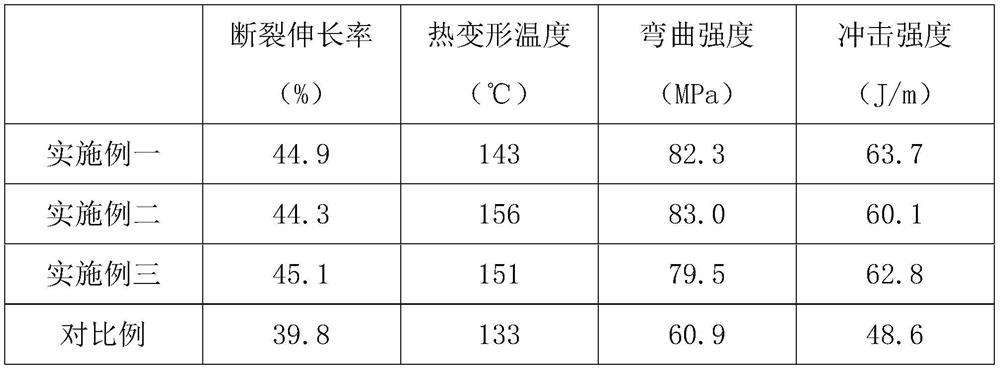Plastic reclaimed material preparation process
A preparation process and recycled material technology, applied in the field of plastics, can solve the problems of brittle product particles, poor mechanical properties, complicated preparation process, etc., and achieve the effect of simple process, good wear resistance and improved mechanical properties
- Summary
- Abstract
- Description
- Claims
- Application Information
AI Technical Summary
Problems solved by technology
Method used
Image
Examples
Embodiment 1
[0023] A preparation process for plastic recycled materials, comprising the steps of:
[0024] S1. Select waste plastics, remove impurities, wash, and crush to obtain waste plastic powder;
[0025] S2. Add the waste plastic powder, the resin mixture, and an appropriate amount of additives into the mixer, stir and mix to obtain a mixture;
[0026] S3, adding the mixture into the extruder to knead evenly, and then extruding;
[0027] S4, cooling the extruded product with cold water, and then drying;
[0028] S5, using a granulator to cut the product into a standard length;
[0029] S6. Screening, measuring, and packaging the cut products to obtain finished products.
[0030] The resin mixture is a mixture of ABS resin and PA resin, and the mass ratio of the ABS resin and PA resin is 1:1.
[0031] The mass ratio of the resin mixture to waste plastic powder is 1:2.
[0032] The auxiliary agent includes the following components in parts by weight: 10 parts of nano-titanium dio...
Embodiment 2
[0038] The difference from Example 1 is that: the mass ratio of the resin mixture to waste plastic powder is 1:3; the additives include the following components in parts by weight: 15 parts of nano-titanium dioxide, 15 parts of nano-titanium dioxide Silicon, 10 parts of glass fiber, 3 parts of antioxidant, 2 parts of dispersant, 2 parts of nucleating agent, 6 parts of lubricant, 15 parts of filler, 10 parts of glyceryl monostearate, 2 parts part of flame retardant, 3 parts of impact modifier, 40 parts of methanol solution; the stirring rate in the step S2 is 800rpm, the stirring time is 45min, and the stirring temperature is 50°C; the extrusion in the step S3 The outlet temperature is set to 180°C for the first stage, 180°C for the second stage, 190°C for the third stage, 195°C for the fourth stage, 195°C for the fifth stage, 220°C for the sixth stage, 220°C for the seventh stage, 225°C for the eighth stage, and 225°C for the machine head; In step S4, the product is cooled by ...
Embodiment 3
[0040] The difference from Example 1 is that: the mass ratio of the resin mixture to waste plastic powder is 1:4; the additives include the following components in parts by weight: 20 parts of nano-titanium dioxide, 20 parts of nano-titanium dioxide Silicon, 15 parts of glass fiber, 5 parts of antioxidant, 3 parts of dispersant, 3 parts of nucleating agent, 7 parts of lubricant, 20 parts of filler, 15 parts of glyceryl monostearate, 3 parts 5 parts of flame retardant, 5 parts of impact modifier, 50 parts of methanol solution; the stirring rate in the step S2 is 1000rpm, the stirring time is 30min, and the stirring temperature is 60°C; the extrusion in the step S3 The outlet temperature is set to 190°C for the first stage, 190°C for the second stage, 200°C for the third stage, 205°C for the fourth stage, 205°C for the fifth stage, 230°C for the sixth stage, 230°C for the seventh stage, 235°C for the eighth stage, and 235°C for the machine head; In step S4, the product is cooled...
PUM
 Login to View More
Login to View More Abstract
Description
Claims
Application Information
 Login to View More
Login to View More - R&D Engineer
- R&D Manager
- IP Professional
- Industry Leading Data Capabilities
- Powerful AI technology
- Patent DNA Extraction
Browse by: Latest US Patents, China's latest patents, Technical Efficacy Thesaurus, Application Domain, Technology Topic, Popular Technical Reports.
© 2024 PatSnap. All rights reserved.Legal|Privacy policy|Modern Slavery Act Transparency Statement|Sitemap|About US| Contact US: help@patsnap.com








